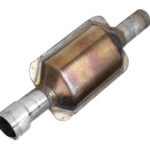Posts Tagged: oxygen sensor
How much does an oxygen sensor replacement cost
Oxygen sensor replacement cost depends on the type of sensor and where it’s located Oxygen sensor replacement cost varies based on whether the sensor is actually an old style oxygen sensor or a more expensive (and more reliable) air/fuel ratio sensor. Many people mistakenly call an air/fuel ratio sensor, an oxygen sensor. An air/fuel ratio sensor does the same thing as an oxygen sensor, but it’s faster, far more accurate, and almost four times the cost of the older style. An older oxygen sensor costs around $80, while an air/fuel … Read More
What tools do you need to replace an oxygen sensor
An oxygen sensor socket set makes easy work of oxygen sensor replacement Many oxygen sensors screw into the exhaust pipe or catalytic converter. When it’s time to replace an oxygen sensor, you’ll need an oxygen sensor socket. However, many air/fuel ratio sensors bolt onto the exhaust manifold. Those can be removed with a socket and ratchet. Here are the instructions for removing screw-in style oxygen sensors. Buy or rent an oxygen sensor socket set Oxygen sensor sockets are special tools that allow you to easily replace an oxygen sensor, even … Read More

How a catalytic converter works
How a catalytic converter works, what it does A catalytic converter converts the various exhaust compounds of hardrocarbons (HC), Oxygen (O2), and Oxides of Nitrogen (N2) into more environmentally friendly gases. If a perfect world, all engines would burn the perfect combination of air and fuel in this ratio: 14.7:1 (air to fuel). After combustion, you would wind up with CO2, H2O and N2. Unfortunately, that never happens in the real world. How your car actually computes the air fuel mixture You’re constantly adjusting the gas pedal and the car … Read More
P2098
Fix code P2098 trouble code on Dodge Stratus, Sebring Trouble code P2098 on a Dodge Sebring or Dodge Stratus indicates that the downstream (post catalytic converter) is reporting a reading that’s consistently above or below center for a predetermined amount of time. Most DIYers replace the oxygen sensor and wonder why they still get the same code. In effect they’re treating the messenger and not the message. An exhaust system has two oxygen sensors. The first sensor tests how well the computer did in calculating air/fuel mixture. The second sensor … Read More
P0137
Fix code P0137 Oxygen Sensor Circuit Low Voltage (Bank 1 Sensor 1). This sensor is located on the engine bank that houses #1 cylinder and is located AFTER the catalytic converter The PCM sends a reference voltage (usually 5-volts) to the variable resistor in the oxygen sensor and looks for a return voltage. Once the sensor is heated up, the PCM expects to see a varying voltage. If the PCM sees a constant low voltage, it will set a trouble code P0137. Most common causes are: vacuum leak that’s allowing … Read More
P0420 Catalyst System Efficiency
P0420 Catalyst System Efficiency Below Threshold (Bank 1) Code P0420 Catalyst System Efficiency Below Threshold (Bank 2) NOTE: Codes P0420 and code P0430 are similar. I wrote a much more detailed explanation of how an emission system works and what causes these codes. Read this post and then refer to this more detailed post. Code P0420 means the catalytic converter for bank 1 has failed it’s testing. The oxygen sensor in front of the catalytic converter switches back and forth between rich and lean as the computer constantly changes air … Read More
P0133 Code — What it means and the most common causes
Learn what a P0133 code means, the most common causes and how to fix it A P0133 code is defined as: 02 Sensor Circuit Slow Response (Bank 1 Sensor 1). Bank 1 is the bank that holds cylinder #1 and sensor 1 is the sensor upstream from the catalytic converter. The code means that the upstream oxygen sensor on the exhaust from bank 1 isn’t reacting as quickly as it should to changing oxygen levels. The ECM is constantly updating the air/fuel mixture and overshooting and undershooting the 14.7:1 ratio. … Read More
